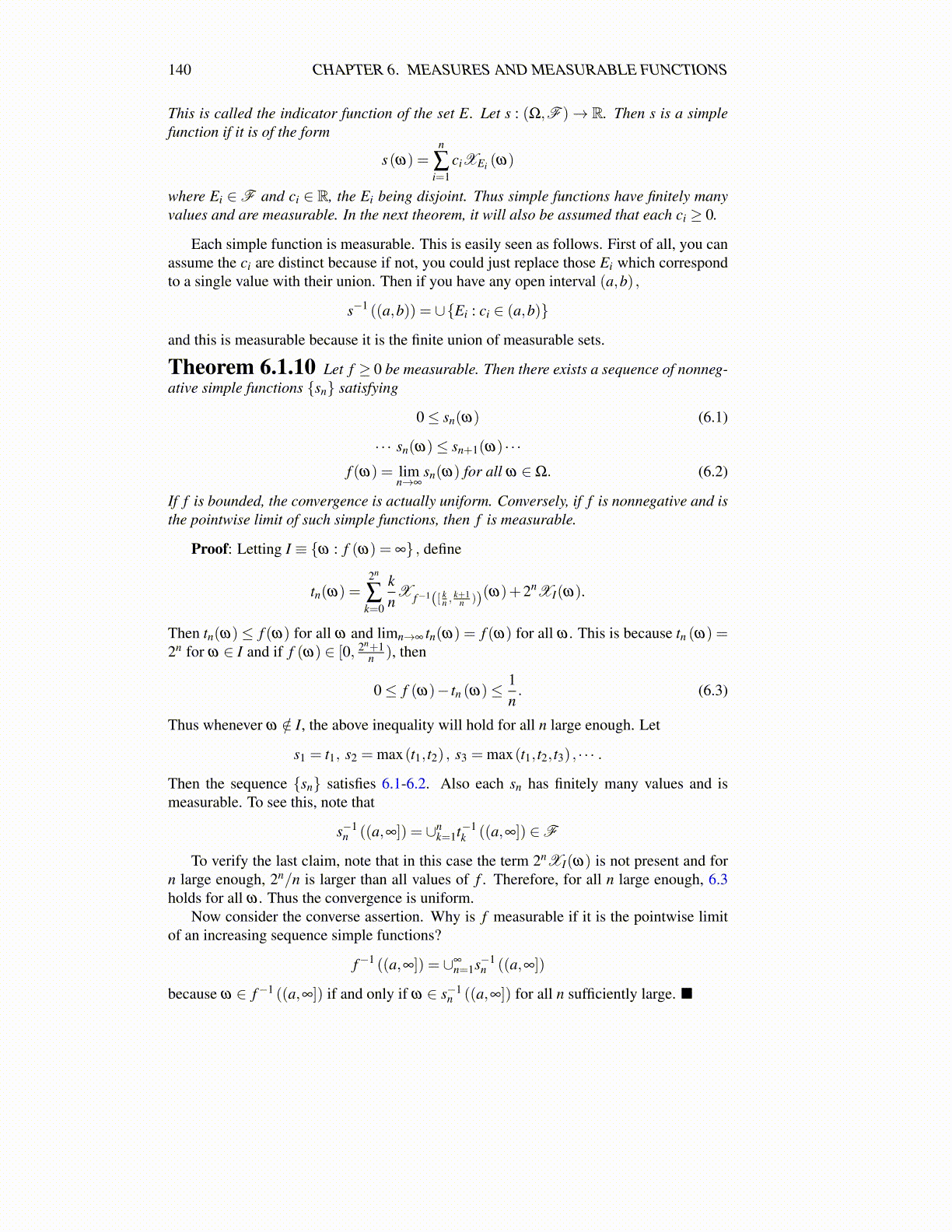
140 CHAPTER 6. MEASURES AND MEASURABLE FUNCTIONS
This is called the indicator function of the set E. Let s : (Ω,F )→ R. Then s is a simplefunction if it is of the form
s(ω) =n
∑i=1
ciXEi (ω)
where Ei ∈F and ci ∈ R, the Ei being disjoint. Thus simple functions have finitely manyvalues and are measurable. In the next theorem, it will also be assumed that each ci ≥ 0.
Each simple function is measurable. This is easily seen as follows. First of all, you canassume the ci are distinct because if not, you could just replace those Ei which correspondto a single value with their union. Then if you have any open interval (a,b) ,
s−1 ((a,b)) = ∪{Ei : ci ∈ (a,b)}
and this is measurable because it is the finite union of measurable sets.
Theorem 6.1.10 Let f ≥ 0 be measurable. Then there exists a sequence of nonneg-ative simple functions {sn} satisfying
0≤ sn(ω) (6.1)
· · · sn(ω)≤ sn+1(ω) · · ·f (ω) = lim
n→∞sn(ω) for all ω ∈Ω. (6.2)
If f is bounded, the convergence is actually uniform. Conversely, if f is nonnegative and isthe pointwise limit of such simple functions, then f is measurable.
Proof: Letting I ≡ {ω : f (ω) = ∞} , define
tn(ω) =2n
∑k=0
knX f−1([ k
n ,k+1
n ))(ω)+2nXI(ω).
Then tn(ω)≤ f (ω) for all ω and limn→∞ tn(ω) = f (ω) for all ω . This is because tn (ω) =2n for ω ∈ I and if f (ω) ∈ [0, 2n+1
n ), then
0≤ f (ω)− tn (ω)≤ 1n. (6.3)
Thus whenever ω /∈ I, the above inequality will hold for all n large enough. Let
s1 = t1, s2 = max(t1, t2) , s3 = max(t1, t2, t3) , · · · .
Then the sequence {sn} satisfies 6.1-6.2. Also each sn has finitely many values and ismeasurable. To see this, note that
s−1n ((a,∞]) = ∪n
k=1t−1k ((a,∞]) ∈F
To verify the last claim, note that in this case the term 2nXI(ω) is not present and forn large enough, 2n/n is larger than all values of f . Therefore, for all n large enough, 6.3holds for all ω . Thus the convergence is uniform.
Now consider the converse assertion. Why is f measurable if it is the pointwise limitof an increasing sequence simple functions?
f−1 ((a,∞]) = ∪∞n=1s−1
n ((a,∞])
because ω ∈ f−1 ((a,∞]) if and only if ω ∈ s−1n ((a,∞]) for all n sufficiently large. ■